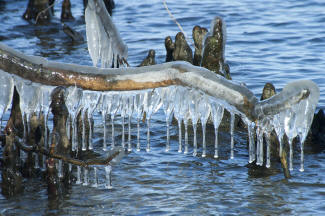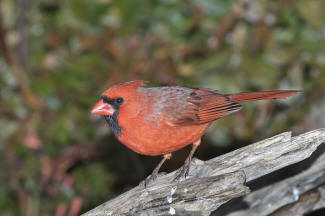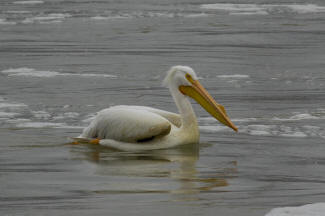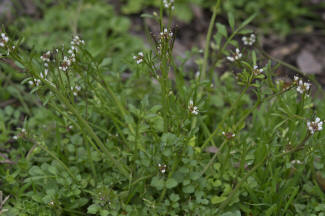PROFILES IN NATURE
The mineral, Ice
Photo Credit – www.kentuckyupclose.com
As I have been a bit under the weather this week I have only
gotten out of the house as necessary. This, coupled with the fact that
snow is so deep on the farm the four- wheeler will barely move, I find
myself looking out the window and thinking about some of the unique
properties that ice has.
Ice of course is the result of chilling water to thirty two
degrees. Everyone knows that
water is formed by two hydrogen atoms and one oxygen atom, H2O. Some of
the hydrogen atoms are shared between different water molecules; this is
called a hydrogen bond. Although not obvious to the human eye, water is
in a state of constant motion. The hydrogen bonds are constantly being
broken and remade with other molecules and this causes the water
molecules to be densely packed. As the temperature nears thirty two
degrees however this constant movement and making and breaking of bonds
slows down. The hydrogen bonds become stronger and tend to “lock” into
place starting to form a hexagonal structure.
This requires four molecules to be locked into place each sharing
the neighboring hydrogen atom. This repetitive latticework of molecules
has larger “holes” between each molecule that liquid water has. This
gives ice an unusual property in that the solid form is less dense than
the liquid form. In nature this has worked out pretty well. Ice floats
on water, if ice was denser than water it would sink to the bottom of
oceans and lakes and without the protective layer on top as we have now
many bodies of water would freeze solid from the bottom up throughout
winter. You can imagine the ecological impact this would have on life as
we know it.
But then man invented water pipes, engine blocks and such. As
water freezes part of the process of becoming less dense involves
expansion. This expansion can be up to nine percent in volume and
involve pressures of several thousand pounds per square inch (possible
to exceed 100,000 psi)! No rigid water pipe can withstand that kind of
pressure. My plumbing has frozen several times this year but fortunately
not hard enough to rupture pipes.
I started this column by calling ice a mineral. We think of
minerals as being such things as quartz, calcite, fluorite, ruby, and
yes, diamonds. However the definition of a mineral is: (1),
naturally occurring (not made by humans)
(2),
inorganic (not produced by an organism)
(3),
solid (4),
a limited range of chemical compositions
(5),
ordered atomic structure. So, although one can’t mount it in a ring ice
is definitely one of nature’s naturally occurring minerals. I just don’t
want to see any more of it for a while unless in a cooler or a nice cold
drink!
Jack
Glisson
Published in The Ballard County Weekly 03/04/2015
PROFILES IN NATURE
Northern Cardinal
Photo Credit – www.kentuckyupclose.com
With the last few weeks of weather I certainly hope several of
you have been feeding the birds. The Northern Cardinal, or
Cardinalis cardinalis, is
probably one of the primary birds folks try to entice to feeders.
This is actually easy to do if sun flower or safflower seeds are
kept out. This will help to discourage black birds, grackles and such. I
usually however put out two or three kinds of feed and enjoy watching a
large variety of species.
Back to the cardinal though. The official state bird of Kentucky
and six other states, it is one of easiest birds to identify and is
recognized by most people. Present in most of the Eastern and Central
United States cardinals are year round residents and rarely migrate. The
male is shown here but the female of this species is attractive as well.
She has a much lighter color with tan and reddish feathers body wide and
lacks the black throat patch but still wears the crown of feathers on
her head.
Feeding on a variety of things such as insects, seeds, grain, and
berries cardinals are usually found in low bushes or on the ground.
Nests are normally located in thick bushes or shrubs anywhere
from three to ten feet from the ground. An average clutch of three to
four eggs are laid which will hatch in around twelve to thirteen days.
The young will leave the nest nine to eleven days later but continue to
be fed for a while by the adults. Insects are the primary food fed to
youngsters. Depending on the length of the season cardinals my raise two
to three broods per year.
Maybe with the melting of this last snow we will begin to hear
mating calls of the northern cardinal. I for one am more than ready to
hear some spring bird and frog calls!
Photo Credit – www.kentuckyupclose.com
Jack
Glisson
Published in The Ballard County Weekly 03/11/2015
PROFILES IN NATURE
American White Pelican
Photo Credit – www.kentuckyupclose.com
If one looks up the American White Pelican, Pelecanus
erthrorhynchos, in a bird book or on line the maps will show that we are
outside their area. There is an occasional mention however that they may
follow the Mississippi River as far north as Saint Louis. Someone needs
to upgrade these maps! For at least the last ten to twelve years and
maybe longer, large flocks of these birds have wintered around Reelfoot
Lake along with the areas below Kentucky and Barkley Dams. They are also
quite common along the Mississippi and Ohio Rivers.
Although White Pelicans winter all along the Gulf Cost and
Florida, folks are more familiar with the brown pelican. This is due to
the fact that the white ones leave in early spring and head north to
their breeding grounds whereas brown pelicans are year round residents
in these areas. During summer and fall when most people take vacations
brown pelicans are the only ones present.
As breeding season approaches both sexes grow a large bump on the
top of their bill called a nuptial tubercle which will fall off
following the breeding season. Nesting in colonies in North-Western US
and Canada the female will lay one to three eggs in a depression on the
ground. Normally only one
chick per nest will survive. Young will then leave the nest when around
three to four weeks old and fledge at around ten weeks.
Brown pelicans feed by dive bombing at fish from the air scooping
them up as they hit the water. White pelicans do not feed in this
manner. They remain on the water and scoop up water and fish then drain
water out of their bill by holding their head in an upright position.
They sometimes feed in groups and may even help each other by driving
fish toward shallow water or each other. An adult white pelican can eat
up to three pounds of fish a day.
American white pelicans are one of the largest birds in North
America, weighing in at up to thirty pounds and having a wing span of up
to nine feet. They fly in a “V” pattern much like geese. Solid white
with black wing tips, these majestic birds make for quite a sight
against a blue sky!
By
Jack Glisson
Published in The Ballard County Weekly 03/18/2015
PROFILES IN NATURE
Hairy Bittercress
Photo Credit – www.kentuckyupclose.com
Well Spring-time has finally arrived! Although march flowers and
henbits are now blooming, one little flowering plant was showing its
buds before the last snow. The green basal leaves are usually there all
winter if one knows what to look for but the tiny white to purplish
flowers bud out in this area in very early spring. Usually the first
plant to flower Hairy Bittercress is common throughout our area.
In lawns and waste places this is the plant with the tiny white
flowers that starts growing before grass and reminds one that mowing
season is right around the corner. Once the seed pod starts forming it
is easily recognized as the pod grows right up through the flower bud,
Although closed much of the time the flowers have four petals and can
sometimes be found open.
Hairy bittercress, or Cardamine hirsuta, is not native to North
America but was imported from Eurasia. It can be used as a cover crop on
bare soil but is best destroyed before seed pods develop unless one
wants it present for fall cover as well. Although it can be persistant,
its low growth really doesn’t seem to hurt gardens or crops.
Although edible, hairy bittercress is considered one of the
bitter herbs. Used sparingly it does add good flavor to wild salads.
Both the leaves and flower buds can be eaten and have a taste similar to
radishes.
As usual when describing edible or medicinal properties I must
add the following disclaimer,
neither the paper nor myself are responsible for the mis-identification
and/or possible untoward effects from eating or otherwise utilizing wild
plants.
By Jack
Glisson
Published in The Ballard County Weekly 03/25/2015



